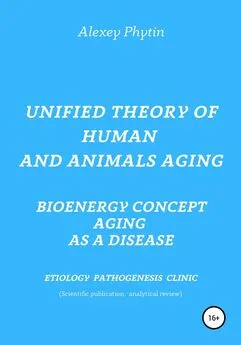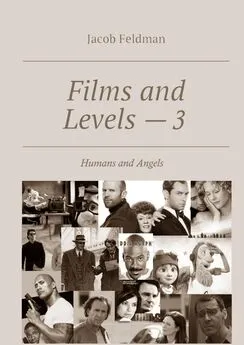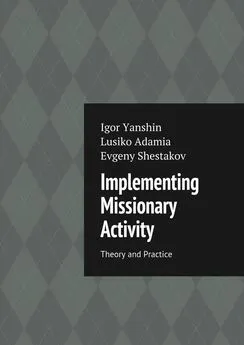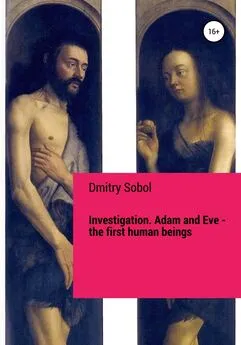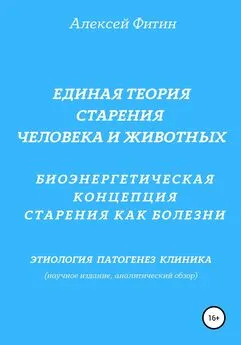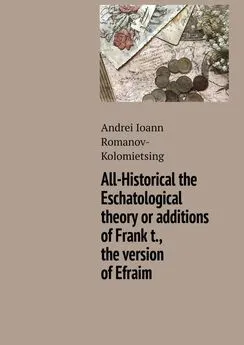Алексей Фитин - Unified theory of human and animals aging. Bioenergy concept aging as a disease
- Название:Unified theory of human and animals aging. Bioenergy concept aging as a disease
- Автор:
- Жанр:
- Издательство:неизвестно
- Год:2022
- ISBN:нет данных
- Рейтинг:
- Избранное:Добавить в избранное
-
Отзывы:
-
Ваша оценка:
Алексей Фитин - Unified theory of human and animals aging. Bioenergy concept aging as a disease краткое содержание
Unified theory of human and animals aging. Bioenergy concept aging as a disease - читать онлайн бесплатно ознакомительный отрывок
Интервал:
Закладка:
Алексей Фитин
Unified theory of human and animals aging. Bioenergy concept aging as a disease
1. Part One
One of the principal objects of theoretical research in any department of knowledge is to find the point of view from which the subject appears in its greatest simplicity.
J. W. GibbsMy Comment to the Epigraph of the Famous Thermodynamicist (Energeticist) Josiah Willard Gibbs
A distinctive feature of biology is the incredible diversity (heterogeneity) of elements and an even greater variety of connections between them. This diversity is manifested at all levels of organization of living things from molecules to social formations.
Obviously, the maximum simplicity of representing such a global phenomenon as aging should not be achieved due to primitive concepts, that is, due to neglect of the complexity of the organism structure.
Obviously, the maximum simplicity of representing such a global phenomenon as aging should not be achieved due to primitive ideas about it, that is, due to neglect of the complexity of its structure. It was energy that turned out to be that golden key, with the help of which I was able to penetrate into the essence of one of the central problems of biology and medicine – aging. Consideration of this complex problem from the standpoint of bioenergetics revealed the very, truly divine simplicity, which made it possible to unravel the complex tangle of numerous facts regarding this phenomenon and predict a number of consequences of energy deficit for the body. I believe that one of the most important results of the bioenergetic approach to aging became the identification of the leading role of the autonomic nervous system in the pathogenesis of this disease.
Science is built up of facts, as a house is built of stones; but an accumulation of facts is no more a science than a heap of stones is a house.
Henri Poincare "Science and Hypothesis", 1902Introduction. How the Bioenergy Concept of Aging Was Born
In connection with the immense breadth of the topic of aging, which must be presented in the limited space of an analytical review, I will present the Concept practically in a thesis form, linking together the etiology and the main stages of pathogenesis by cause-and-effect relationships. As “test words” in the second part of the review, I will present an explanation within the framework of the Concept of a number of long-known phenomena of aging and the most significant facts characterizing this disease, but which have not received a clear explanation within the framework of other hypotheses.
I will cite only the most important facts necessary for an adequate understanding of the Concept and will try not to overload the text with references to facts widely known to gerontologists and geriatricians. The modern possibilities of the Internet allow readers to quickly find the most recent works available in the open access and concerning any fact mentioned in the review.
There are no new facts concerning aging in this work. The Concept offers a new look at this disease, its etiology and pathogenesis. A patient has a chance to be healed if the pathogenic factor that caused his disease (etiology) and the sequence of events in the mechanism of the development of his disease (pathogenesis) are known.
Treatment of aging, like any other disease, blindly or by symptoms, without knowledge of the etiology and pathogenesis, is not only useless, but also harmful (pathogenic) occupation. Many modern authors have already called aging a disease, and not a process, as has been accepted since the second century AD. However, most of them are limited only by etiology and often scattered elements of pathogenesis, linking them to its terminal stages. We do not know anything about the early stages of the pathogenesis of aging. Most of the clearly formulated aging hypotheses are based on pathogenic factors causing chaos in the metabolism of cells and tissues: – on numerous toxic metabolites of the intestinal bacterial flora [1]; – on highly reactive metabolites – free radicals of oxygen and nitrogen, entering into chemical reactions with biological polymers [2] and on chemically active aldehyde – glucose, which modifies amino groups of proteins, with excessive consumption of sugars. The hypothesis of accumulation of mutations is also based on chaos [3].
All of the above hypotheses, in fact, are one-act (primitively simple) and are suitable for explaining only pathological, but in no way physiological aging. Chemical or physical (energy quanta: electrons, photons, alpha particles) impact of a set of pathogenic factors on a huge list of targets in the human body – enzymes, transmembrane carriers, structural proteins, nucleic acids and phospholipids should lead to an unimaginable variety of effects on everyone levels of the organization.
The first stage of pathogenesis, with a similar beginning of aging, can be designated as "metabolic chaos", which eventually leads to the second stage – a "black box", about which, in principle, we do not know anything. And unexpectedly, at the later stages of pathogenesis, the interaction of these two sets – pathogenic factors and targets, leads to a quite definite set of one and a half dozen proliferative-degenerative senile pathologies with quite predictable general unified events of pathogenesis.
Trying to explain this paradoxical phenomenon, I came to the conclusion that the listed pathogenic factors on their own can hardly be the cause of physiological aging.
As for pathological aging, which can be influenced by a huge number of pathogenic factors of a very different nature, even in this case, I doubt that each pathogenic factor that provokes or aggravates pathological aging has its own unique mechanism of action on this disease. I assumed that a huge variety of pathogenic factors of the most diverse nature affects pathological aging through a unified mechanism.
The path to the main and unique pathogenic factor, the same for physiological and pathological aging, which not only initiates, but also prolongs this disease at different stages of pathogenesis, turned out to be quite long and with numerous dead ends.
Analyzing the research results of V. M. Dilman [4] regarding age-related coarsening of the sensitivity of the hypothalamus functions to peripheral regulatory signals of negative feedback (peripheral hormones and key metabolites), accompanied by an increase in the basal level of one of the stress hormones, cortisol, I suggested that in addition to hormonal and metabolic signals that determine this phenomenon, there is a more powerful and significant regulator of the activity of the hypothalamus – the peripheral part of the autonomic nervous system (ANS) – evolutionary metabolic regulation system No. 1, which ensures the rapid adaptation of the body to changing conditions as the environment and the internal environment of the body. I was convinced of this by the results of experiments W. B. Cannon [5] by removing in animals the sympathetic ganglia of the ANS, which provide the neural connection of the brain stem structures with the periphery.
Such an operation did not lead to any significant disturbances in the normal life of animals at rest and under constant environmental conditions. However, such animals lost the ability to quickly adapt and died from insignificant stressful influences. The behavior of the operated animals with a distant peripheral sympathetic nervous system reminded me of the behavior of elderly people. This similarity was expressed in a low threshold of a stress response to what seemed to be the most insignificant, both external and internal influences, manifested in humans in inadequately strong and unreasonable feelings, fears and worries.
This strengthened me in the consciousness that I was on the right track. I became interested in the fine structure of the ANS and the structural features of the neurons of this metabolic regulation system, looking for weak links that could make it the most vulnerable component of the aging mechanism of the body. The success of the search was largely predetermined by my “bioenergetic” past in science [6]. Since then, I have viewed all significant aging events through the prism of bioenergetics.
Such weak links were quickly discovered – incredibly extended processes of pseudo-unipolar neurons, in which a single axon leaves the cell body, splitting into two branches: a long one towards the sense organ and a short one towards the central nervous system, as well as slow and energy-consuming processes of axonal transport over long distances of tens of centimeters, which determines the slow process of their regeneration.
The volume of cytoplasm located in the extended processes of such neurons is hundreds of times greater than the volume of cytoplasm in the body of the neuron, in which the nucleus and the Golgi apparatus are localized, supplying the processes with all the necessary “building materials” for their growth and regeneration due to slow axonal vesicular transport, the speed which is much less than the blood flow velocity. The speed of vesicular transport in the axon reaches 20–50 cm / day, and the blood flow rate is in the range from 0.03 cm / sec in the capillaries to 40 cm / sec in the aorta.
Thus, the rate of vesicular axonal transport of mitochondria and enzymes accumulated in the Golgi apparatus and is 50–70000 times less than the rate of transport of nutrients by the circulatory system. This difference predetermines the limiting stage of the regeneration process of axons damaged in one way or another, which is from 2 to 5 mm per day. I came to the conclusion, that it is the energetics of these unique neurons that can be a limiting factor in their effective work and the regeneration of their offshoots. And since the energetics of a neuron is based on oxidative phosphorylation, I came to the preliminary conclusion that only oxygen can be the initial limiting factor in the work of these unique neurons. Later it turned out that the weakest point of these neurons are the terminal areas of axons farthest from the cell nucleus and from the Golgi apparatus, on which receptors are localized and which are capable of regeneration after physiological degeneration.
1.1 Etiology of Aging
The death of the body is the inevitable outcome of the disease of aging. When assessing the dynamics of aging, two indicators are important – the average indicator and the indicator of the maximum life expectancy.
Searching for the stages of pathogenesis that limit a long and healthy life, I came to the conclusion that the indicator of the maximum or species life expectancy is associated with physiological aging (senescence) and depends on the only unique internal pathogenic factor – oxygen deficiency in organs and tissues and is determined by specific (per unit mass of body weight per unit of time) by the rate of formation of carriers of free energy : adenosine triphosphoric acid (ATP), reduced forms of nicotinamide-adenine dinucleotides (NADH, NADPH), reduced forms of flavine-adenine dinucleotide (FAD) and acetyl-coenzyme A (acetyl-CoA). [1] Free energy or Gibbs-Helmholtz energy – part of the internal energy of molecules that can be converted into work during reactions.
Indicator of maximum life expectancy has not changed over the centuries and therefore is a species-specific feature. At the same time, the partial pressure of oxygen in different organs and tissues differs significantly, and therefore the levels of hypoxia, normoxia and hyperoxia for each organ and each tissue are unique [7].
Читать дальшеИнтервал:
Закладка:
